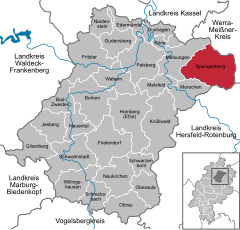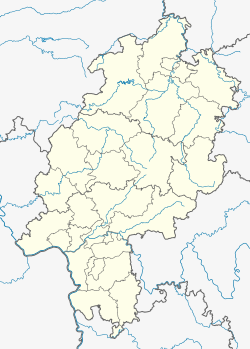Spangenberg is a small town in northeastern Hesse, Germany.
Spangenberg | |
|---|---|
Location of Spangenberg within Schwalm-Eder-Kreis district  | |
| Coordinates: 51°7′N 9°40′E / 51.117°N 9.667°E | |
| Country | Germany |
| State | Hesse |
| Admin. region | Kassel |
| District | Schwalm-Eder-Kreis |
| Subdivisions | 13 Stadtteile |
| Government | |
| • Mayor (2021–27) | Andreas Rehm[1] |
| Area | |
| • Total | 97.7 km2 (37.7 sq mi) |
| Highest elevation | 530 m (1,740 ft) |
| Lowest elevation | 200 m (700 ft) |
| Population (2022-12-31)[2] | |
| • Total | 6,122 |
| • Density | 63/km2 (160/sq mi) |
| Time zone | UTC+01:00 (CET) |
| • Summer (DST) | UTC+02:00 (CEST) |
| Postal codes | 34286 |
| Dialling codes | 05663 |
| Vehicle registration | HR |
| Website | www.spangenberg.de |
Geography
editSpangenberg lies in the Schwalm-Eder district some 35 km (22 mi) southeast of Kassel, west of the Stölzinger Gebirge, a low mountain range. Spangenberg is the demographic centrepoint of Germany.
History
editThe town of Spangenberg had its first documented mention in 1261, at about the time when the Treffurt family ruled Spangenberg.
Historic sights
editThe town is known best of all for Spangenberg Castle, built in 1253 and the town's landmark. Also worth seeing are the half-timbered buildings in the Old Town and the remains of the town's old wall, several of whose towers are still standing.
In World War II, Spangenberg Castle was used as a prisoner of war camp, Oflag IX-A/H. There was a second camp a few miles to the south - Oflag IX-A-Z.[3]
Coat of arms
editSpangenberg's civic coat of arms is based on the town's oldest known seal from 1317. The object on the viewer's right (heraldically speaking, the left, as the shield is considered from the point of view of the bearer) side is a kind of fossilized plant locally known as a Spange (also German for "brooch" or "clip"), the town's namesake. The item on the viewer's left (heraldic right) is half of a wheel. Wheels are common in German civic heraldry, usually indicating some connection to the Archbishopric of Mainz, whose arms include wheels in honor of St. Willigis. The current colours – red and gold – have been in use since 1621.[4]
Constituent communities
editIn alphabetical order, these are Bergheim, Bischofferode, Elbersdorf, Herlefeld, Kaltenbach, Landefeld, Metzebach, Mörshausen, Nausis, Pfieffe, Schnellrode, Vockerode-Dinkelberg and Weidelbach.
Partnerships
editSpangenberg maintains partnerships with the following places:
- Treffurt, Thuringia since 1990
- Saint-Pierre-d'Oléron, Charente-Maritime, France since 1997
- Pleszew, Poland since 1997
Famous people
- Henry II, Landgrave of Hesse (before 1302-1376), Landgraf, resided at Schloss Spangenberg
- Hermann II, Landgrave of Hesse (1341-1413), Landgraf, resided at the castle
- William I, Landgrave of Lower Hesse (1466-1515), Landgraf, died at Schloss Spangenberg
- Philip I, Landgrave of Hesse (1504-1567), Landgraf, lived at Schloss Spangenberg
- William IV, Landgrave of Hesse-Kassel (1532-1592), Landgraf, gave the castle its present form
- Margarethe von der Saale (1522-1566), sister of Philip the Magnanimous, lived in the castle seat, her grave is in the city church of St. John
- Hans Wilhelm Kirchhof (1525-1605), Burggraf on Schloss Spangenberg
- Michael Rutschky (born 1943), writer, grew up in Spangenberg
References
edit- ^ "Ergebnisse der letzten Direktwahl aller hessischen Landkreise und Gemeinden" (XLS) (in German). Hessisches Statistisches Landesamt. 5 September 2022.
- ^ "Bevölkerung in Hessen am 31.12.2022 nach Gemeinden" (XLS) (in German). Hessisches Statistisches Landesamt. June 2023.
- ^ "British Prisoners of war in European Camps during the Second World War 1939-1945". www.forces-war-records.co.uk. Retrieved 2020-11-29.
- ^ Heraldry of the World


